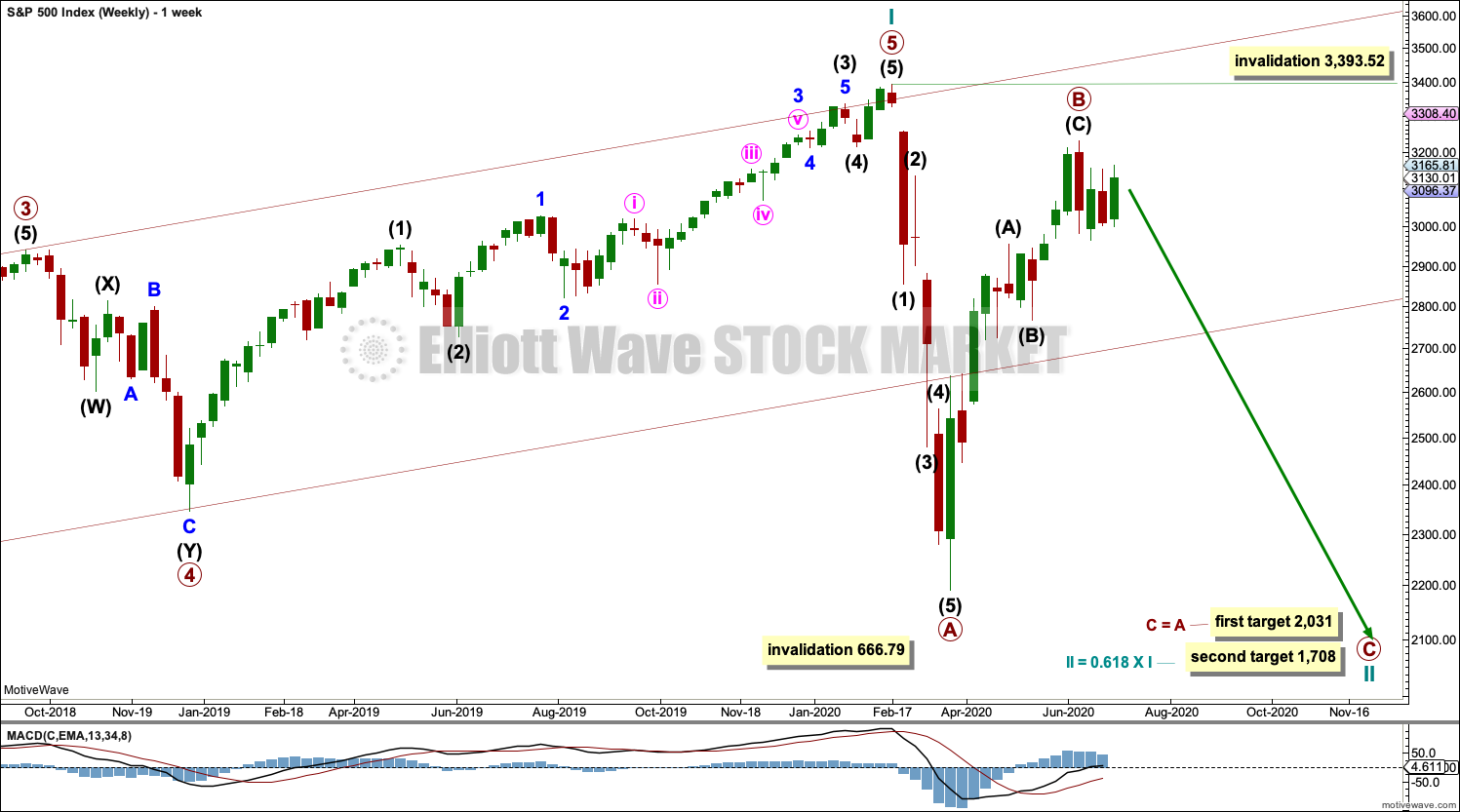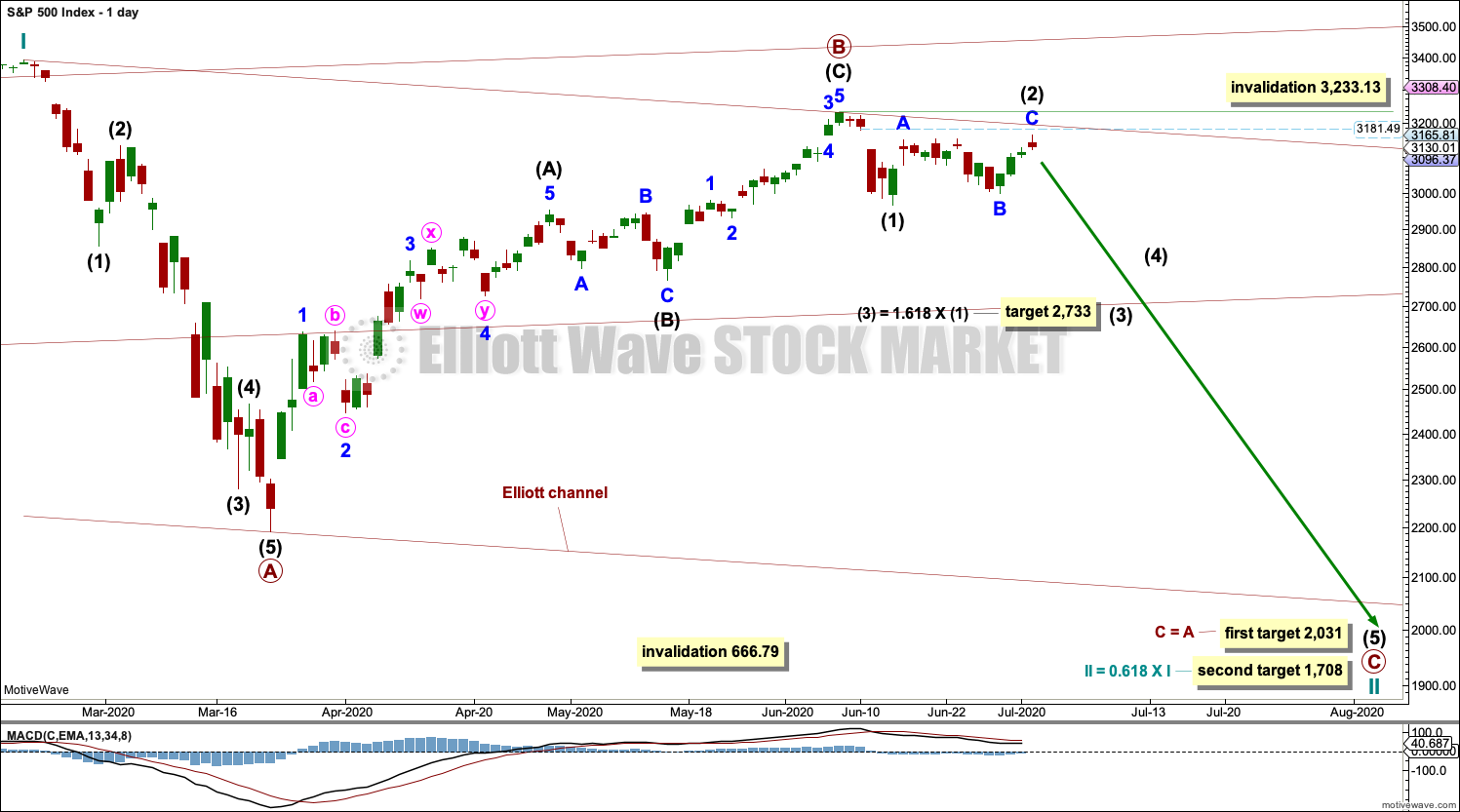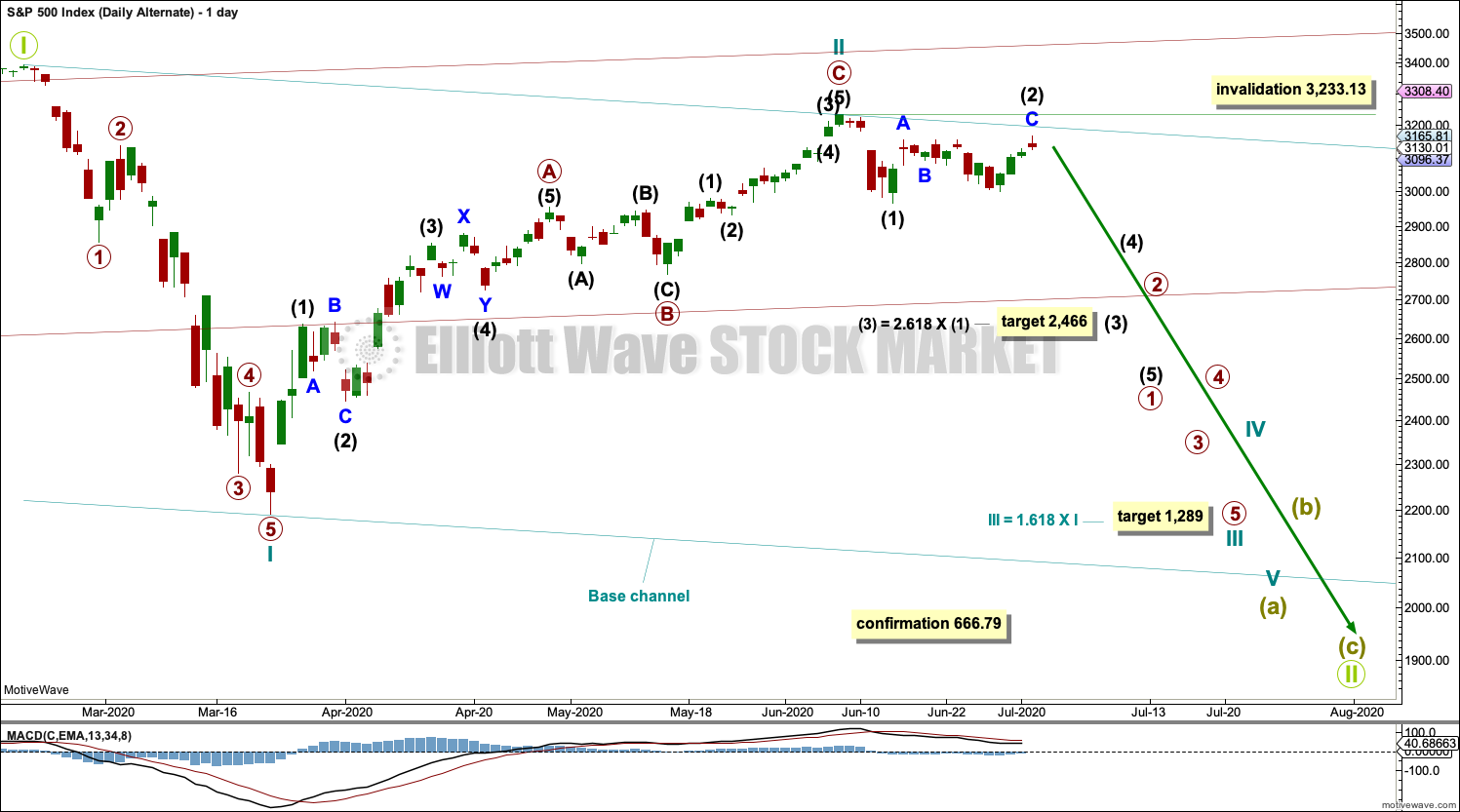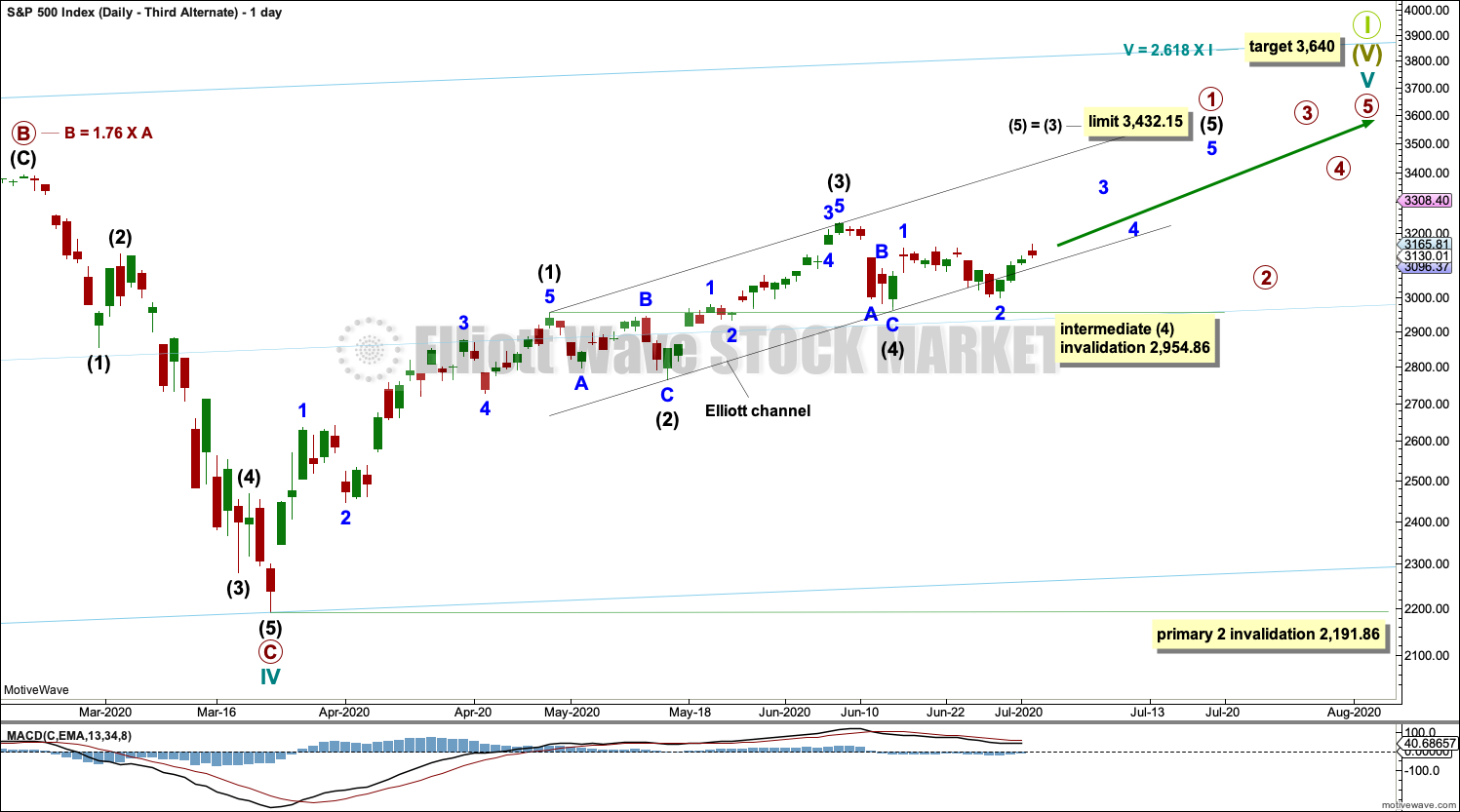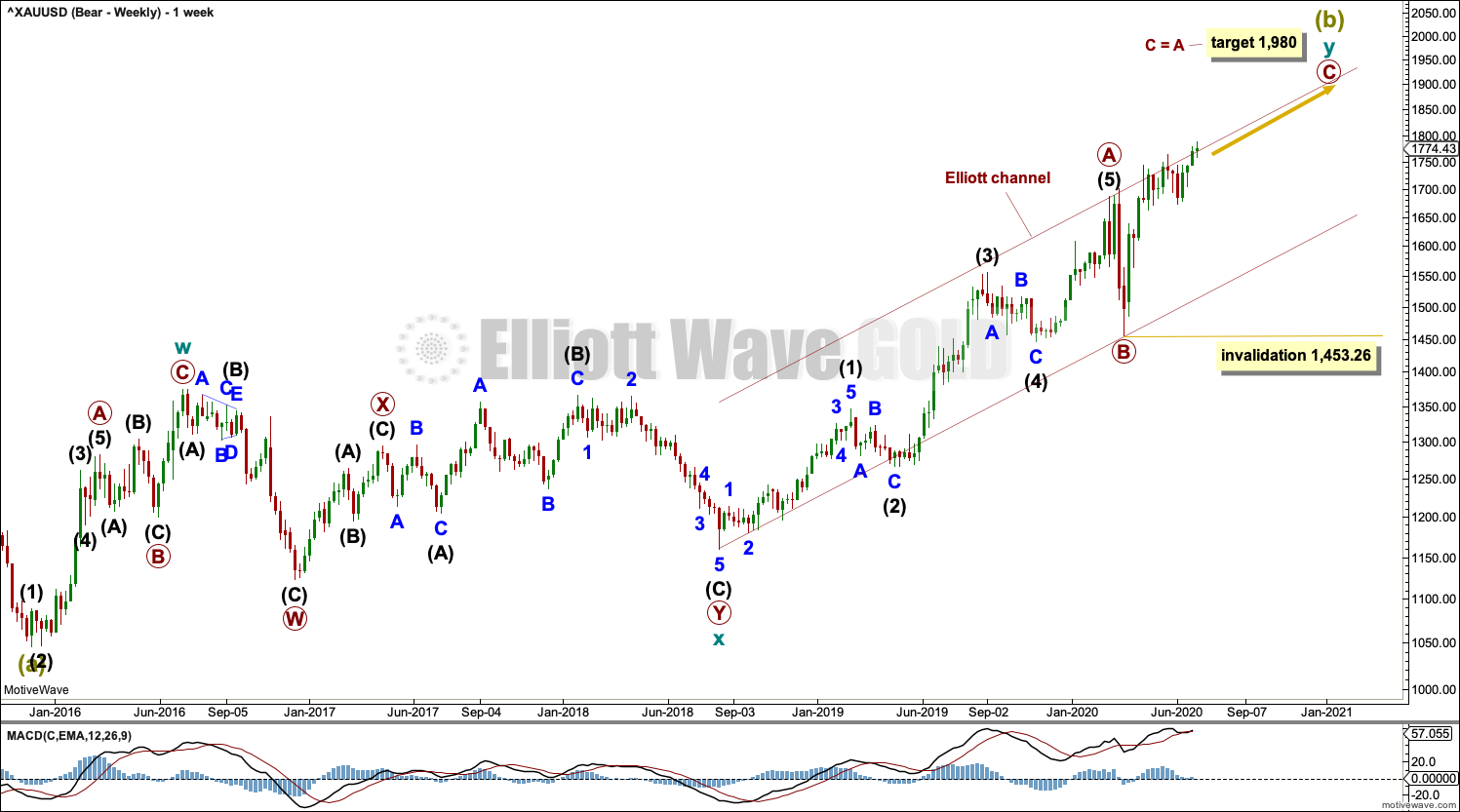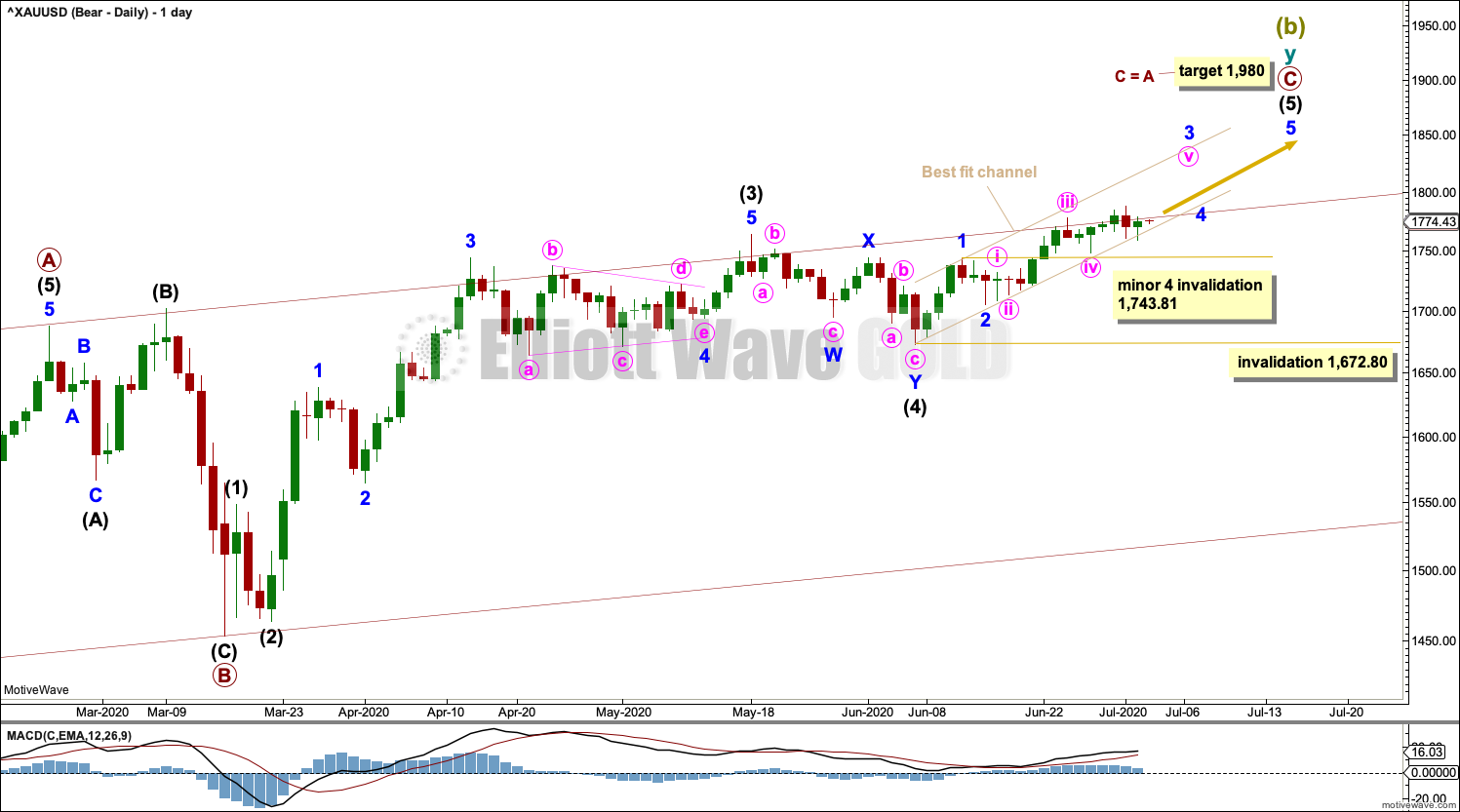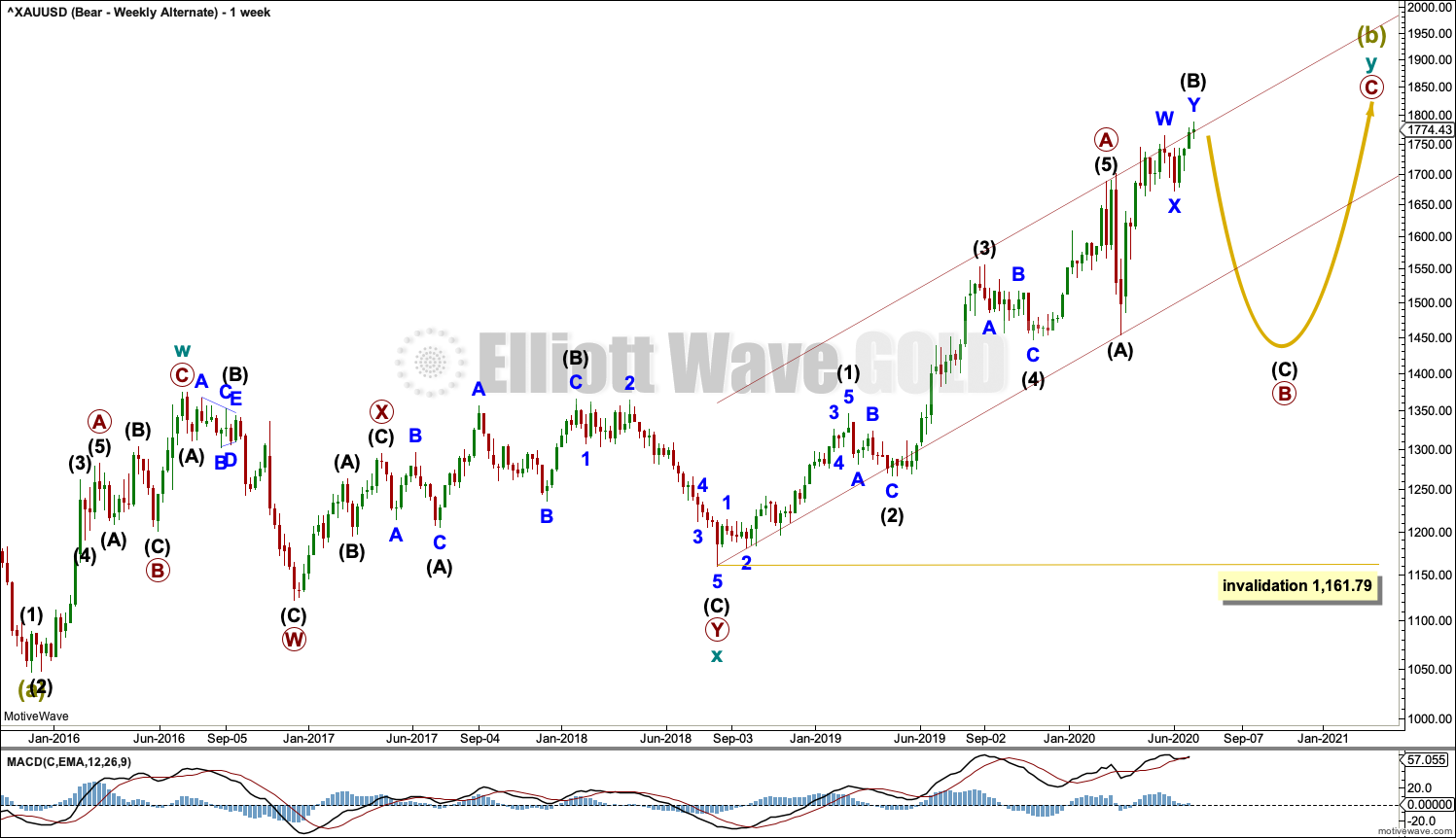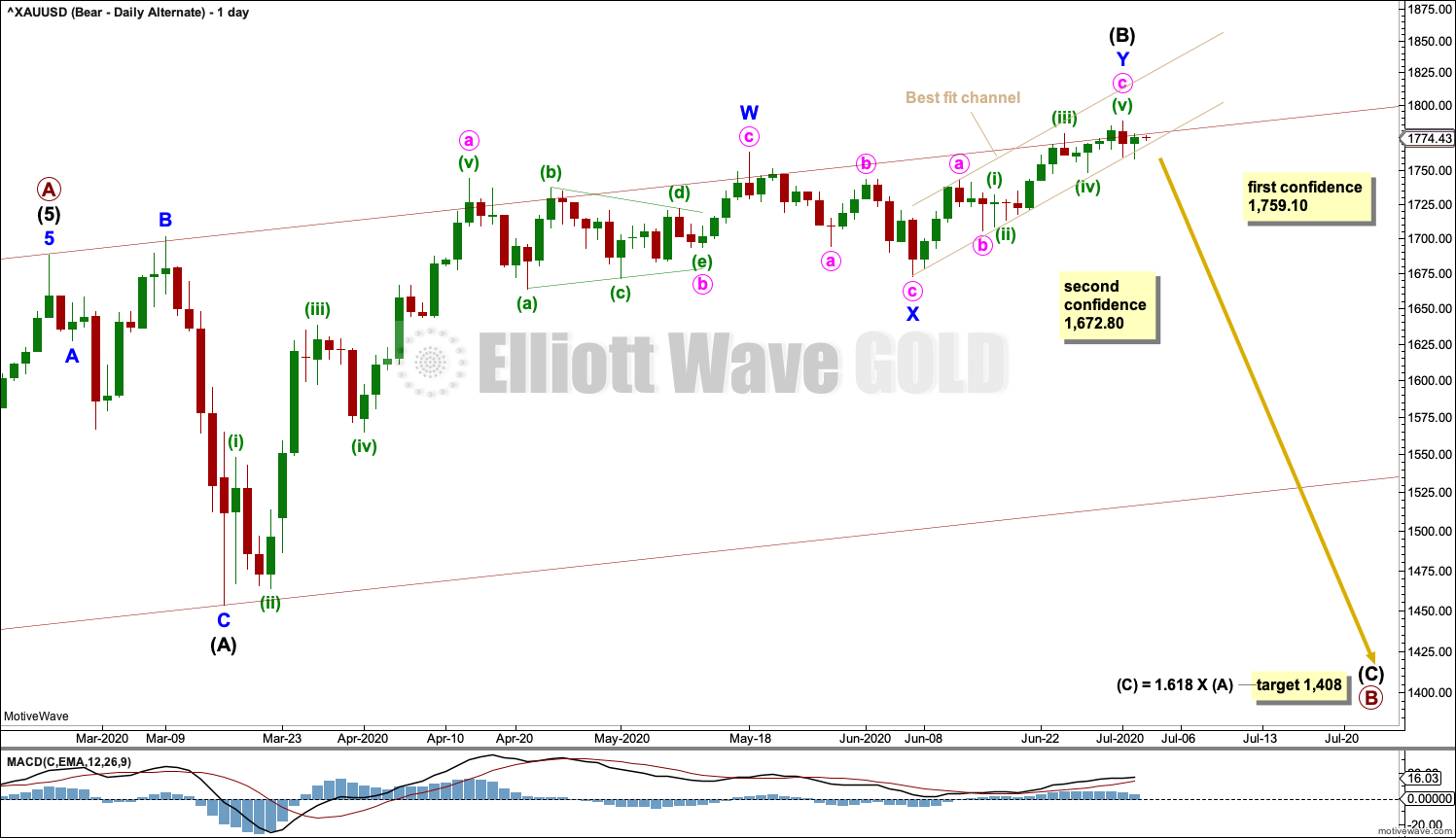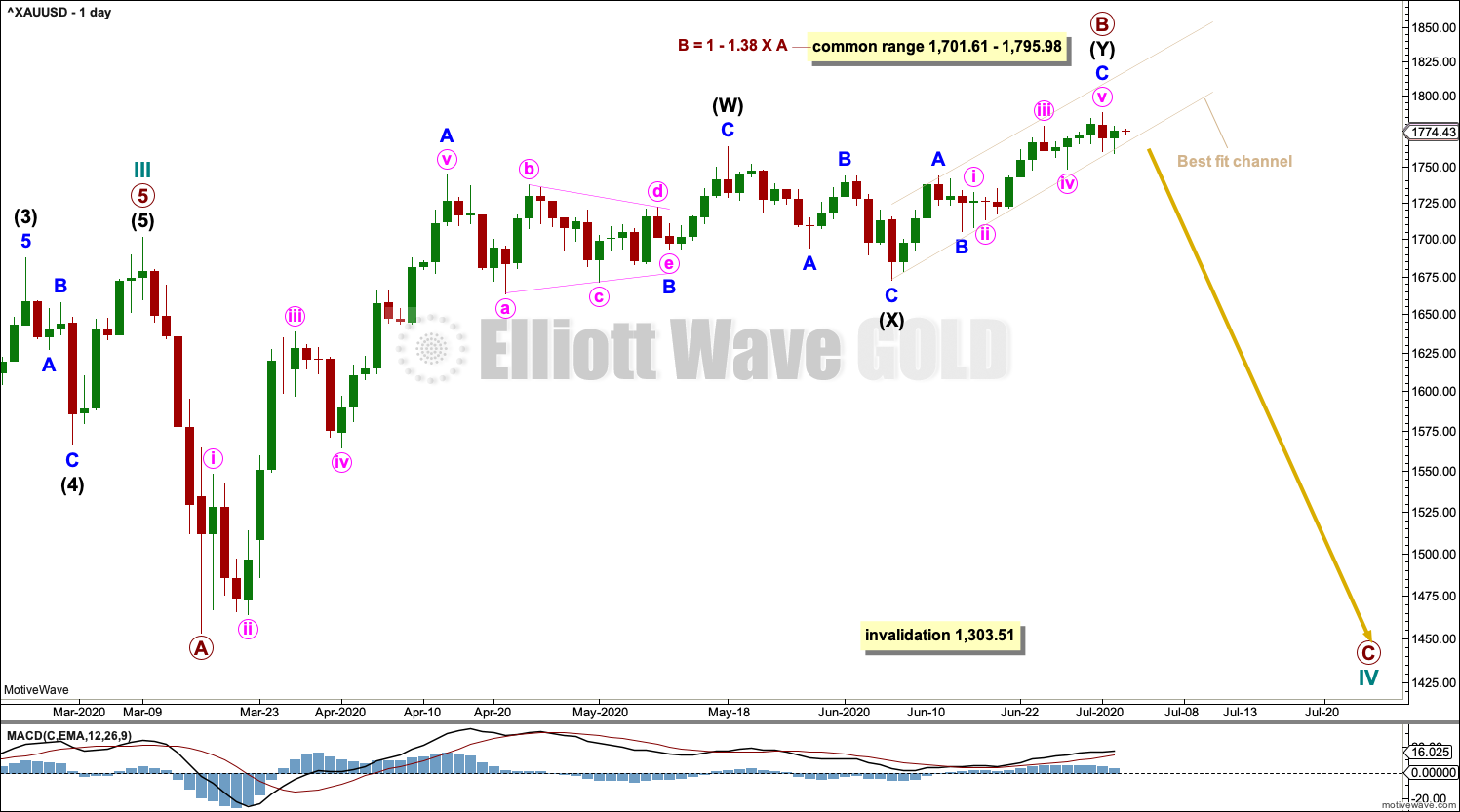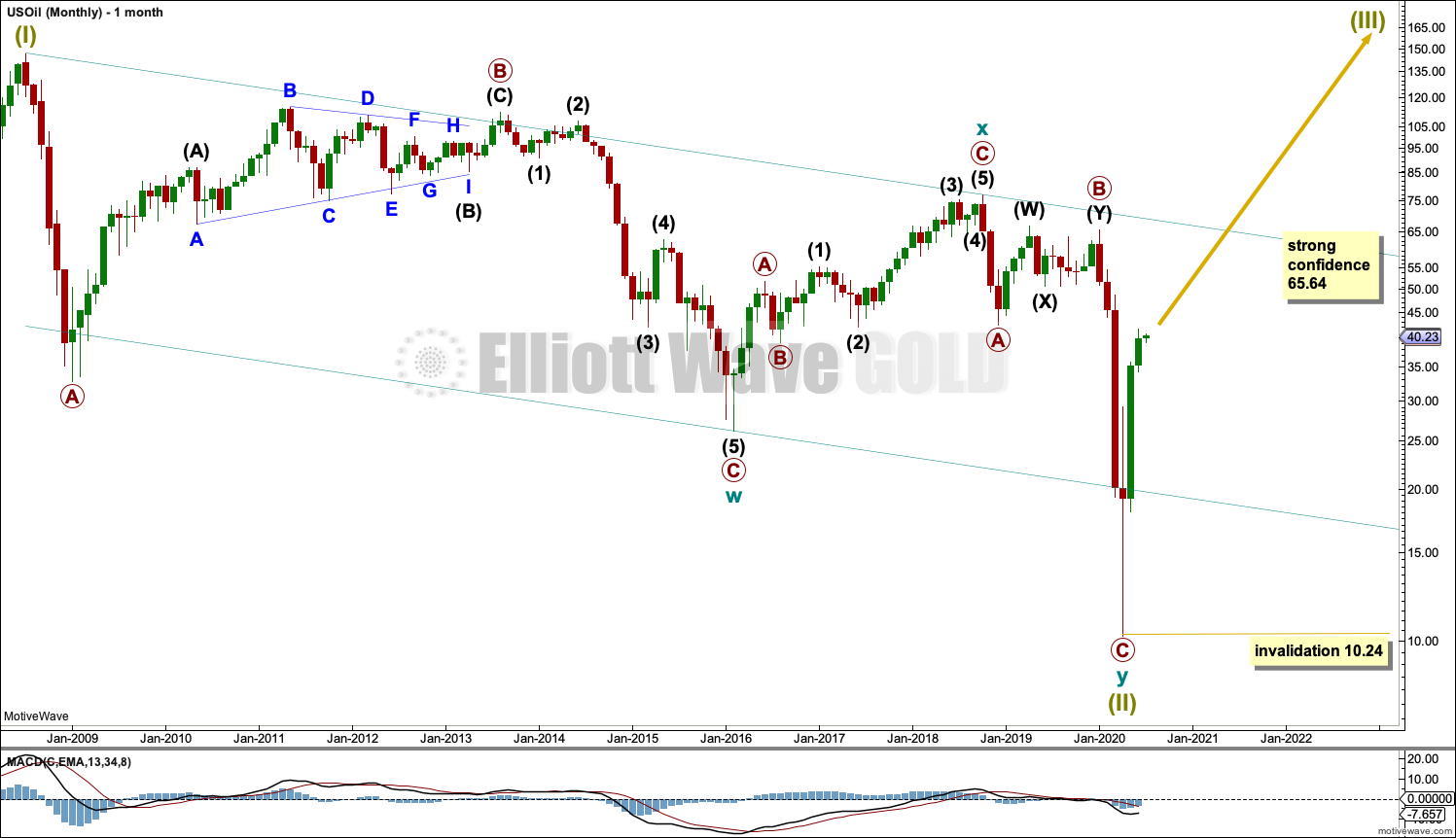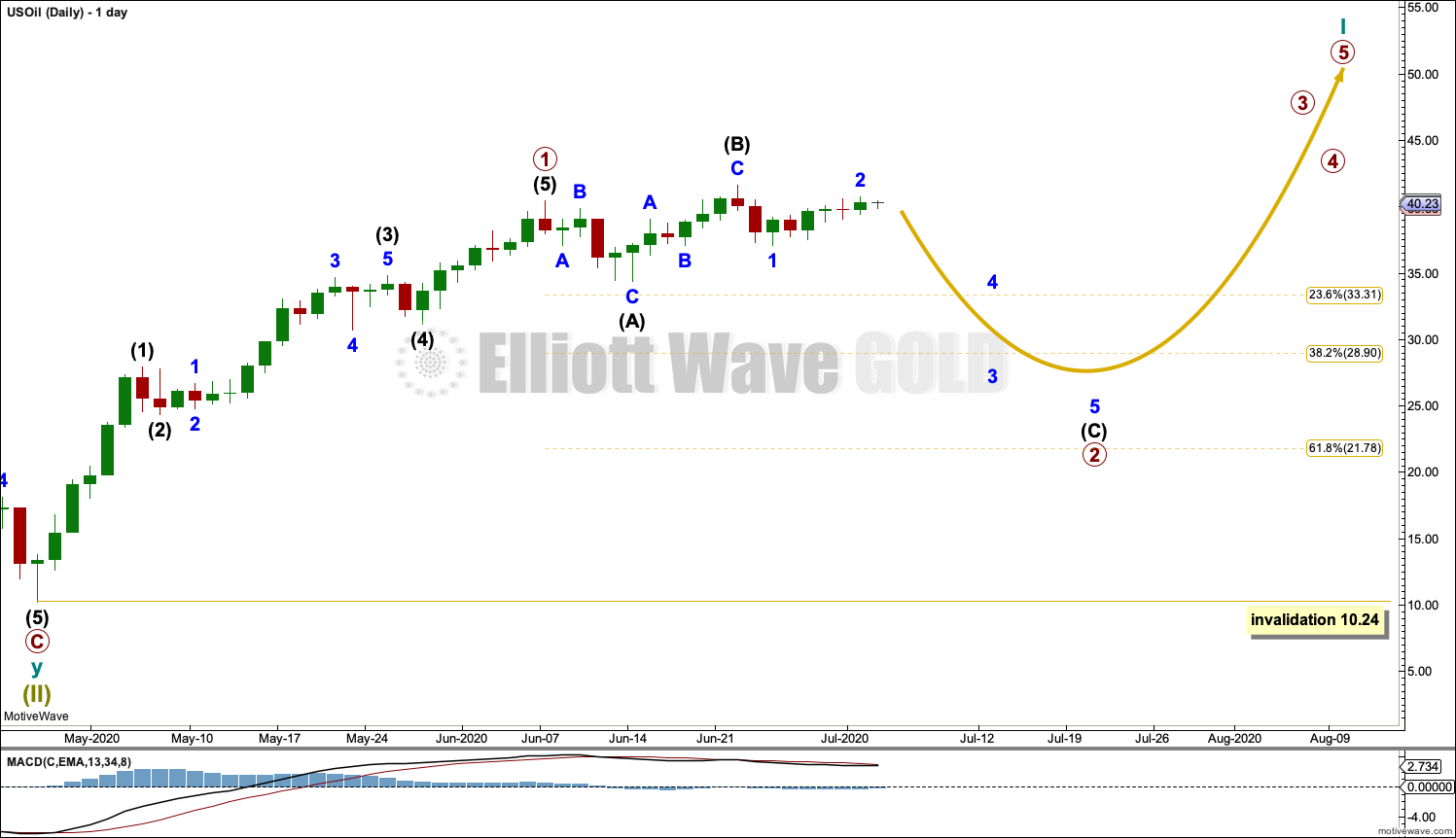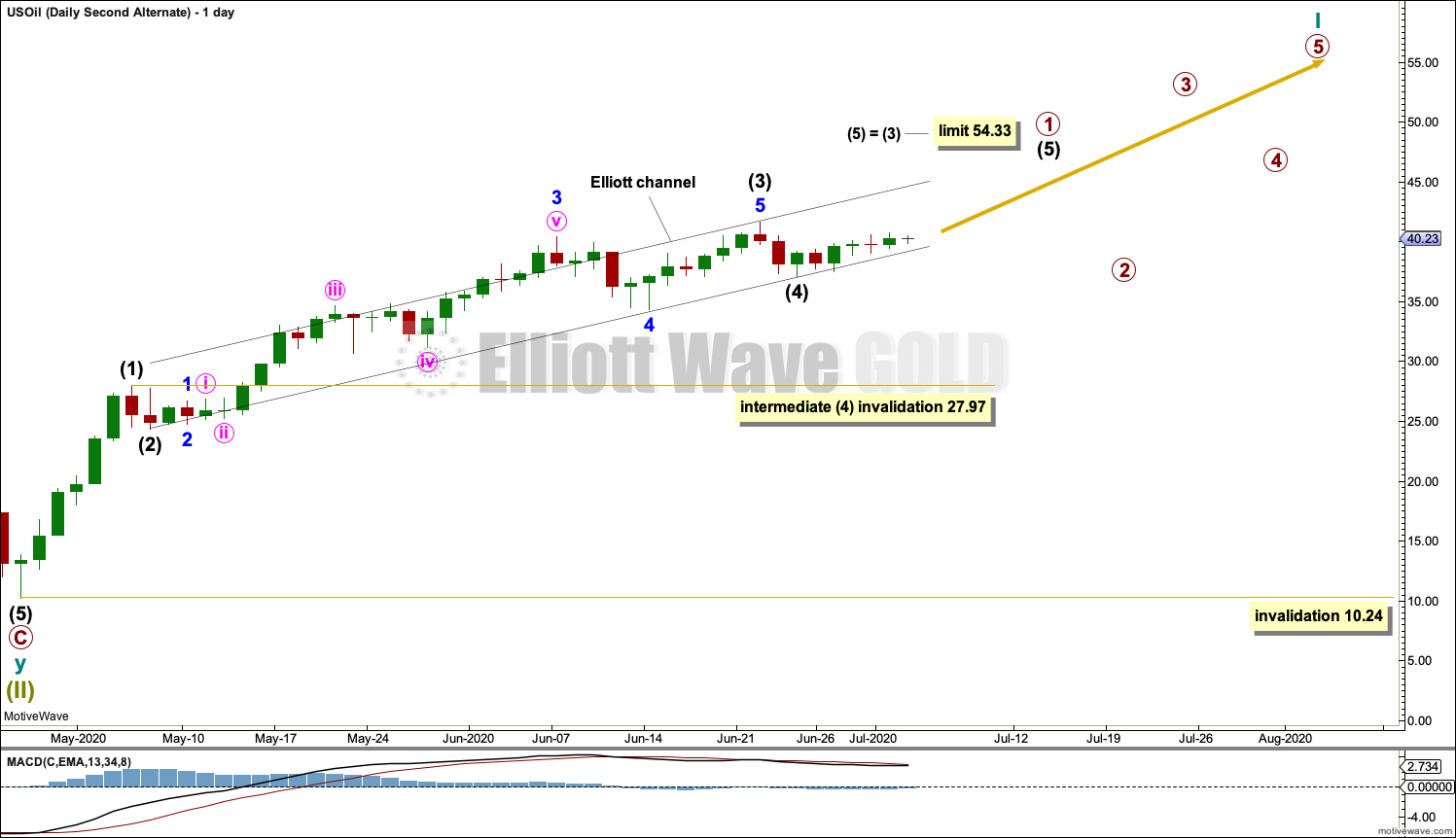Lara’s Weekly: Elliott Wave and Technical Analysis of S&P500 and Gold and US Oil | Charts – July 3, 2020

S&P 500
Upwards movement for the session breached the short-term invalidation point but remains below identified strong resistance at the Island Reversal.
Summary: Downwards movement may resume. For the long term, a sustainable high may now be in place on June 8th.
A mid-term target is at 2,723. The main wave count has two final targets at 2,031 and 1,708. The daily alternate wave count has a target at 1,289 for a third wave down.
Resistance may be very strong at 3,181.49.
A new low below 2,954.86 would invalidate the third alternate wave count and provide confidence in downwards targets.
The third alternate wave count outlines a bullish scenario. A new high above 3,233.13 would be required for confidence in this wave count.
The biggest picture, Grand Super Cycle analysis, is here.
Last monthly charts are here. Video is here.
ELLIOTT WAVE COUNTS
MAIN WEEKLY CHART
This main Elliott wave count expects that the bull market beginning in March 2009 was cycle wave I of Super Cycle wave (V). The trend change in February 2020 may have been only at cycle degree. Cycle wave II may last from one to a few years.
Cycle wave II would most likely subdivide as a zigzag; thus far that looks like what is unfolding. Primary waves A and B may both be complete. A second target is calculated at primary degree.
Cycle wave II may not move beyond the start of cycle wave I below 666.79.
MAIN DAILY CHART
Draw the wide maroon trend channel carefully: draw the first trend line from the end of primary wave 1 at 2,093.55 (December 26, 2014), to the end of primary wave 3 at 2,940.91 (September 21, 2018), then place a parallel copy on the end of primary wave 2 at 1,810.10 (February 11, 2016). The channel was fully breached in March 2020 indicating a trend change from the multi-year bull trend to a new bear trend. Resistance at the lower edge has been overcome; price has closed above this trend line. During the next downwards wave this line may offer some support.
Cycle wave II may subdivide as any Elliott wave corrective structure except a triangle. It would most likely be a zigzag (zigzags subdivide 5-3-5). It may now be complete.
Draw a channel about cycle wave II using Elliott’s technique for a correction. Draw the first trend line from the start of primary wave A to the end of primary wave B, then place a parallel copy on the end of primary wave A. Primary wave C may find support about the lower edge of this channel.
Intermediate wave (1) within primary wave C may be complete. Intermediate wave (2) may have moved higher today; it may be complete at this week’s high. At the daily chart level, intermediate wave (1) looks like a five and intermediate wave (2) looks strongly like a three.
If intermediate wave (2) continues any higher, then it may not move beyond the start of intermediate wave (1) above 3,233.13, although the gap that forms the Island Reversal at 3,181.49 may provide very strong resistance.
A target is calculated for intermediate wave (3).
Two targets are calculated now for primary wave C. If price approaches the first target and either the structure of primary wave C is incomplete or price keeps falling, then attention would turn to the second target.
FIRST ALTERNATE DAILY CHART
This alternate daily chart follows the First Alternate Monthly chart.
By simply moving the degree of labelling in the bull market beginning March 2009 up one degree, it is possible that a Grand Super Cycle trend change occurred on February 19, 2020. The bull market from March 2009 to February 2020 may have been a complete fifth wave labelled Super Cycle wave (V).
A bear market at Grand Super Cycle degree may be expected to last at least a decade, possibly longer. Corrections for this market tend to be much quicker than bullish moves, and so a fair amount of flexibility is required in expectations for duration of the different degrees.
Grand Super Cycle II would most likely subdivide as a zigzag, although it may be any corrective structure except a triangle. It should begin with a five down at the weekly chart time frame, which would be incomplete.
The first wave down on the daily chart is labelled cycle wave I. If this degree of labelling is wrong, it may be too high; it may need to be moved down one degree.
Following cycle wave I, cycle wave II may be a complete zigzag. A target for cycle wave III is now calculated.
Intermediate wave (2) may not move beyond the start of intermediate wave (1) above 3,233.13.
A target is recalculated for intermediate wave (3).
THIRD ALTERNATE DAILY CHART
This alternate daily chart follows the third alternate monthly chart. It will be published daily because the structure of the current upwards wave is different and so the invalidation point is different. This alternate chart labels the subdivisions of the long bull market differently. The channel is a best fit.
The target for the end of this bull market is provisional. It would best be calculated at primary degree, but that cannot be done until all of primary waves 1 through to 4 are complete. At that stage, the target will be recalculated and will very likely change.
Cycle wave V must subdivide as a five wave motive structure, most likely an impulse. Primary wave 1 within cycle wave V may be nearing completion.
Within primary wave 1: intermediate waves (1) through to (3) may be complete and intermediate wave (4) may not move into intermediate wave (1) price territory below 2,954.86.
Use Elliott’s first technique to draw a channel about primary wave 1. Draw the first trend line from the ends of intermediate waves (1) to (3), then place a parallel copy on the end of intermediate wave (2). Intermediate wave (4) remains within the channel and may have found support about the lower edge.
When primary wave 1 may be a complete five wave structure, then primary wave 2 should then unfold as a multi-week pullback and may not move beyond the start of primary wave 1 below 2,191.86.
In the short term, invalidation of this wave count by a new low below 2,954.86 would add confidence to the first two wave counts.
This alternate wave count is bullish.
Cycle wave V may last from one to several years.
TECHNICAL ANALYSIS
WEEKLY CHART
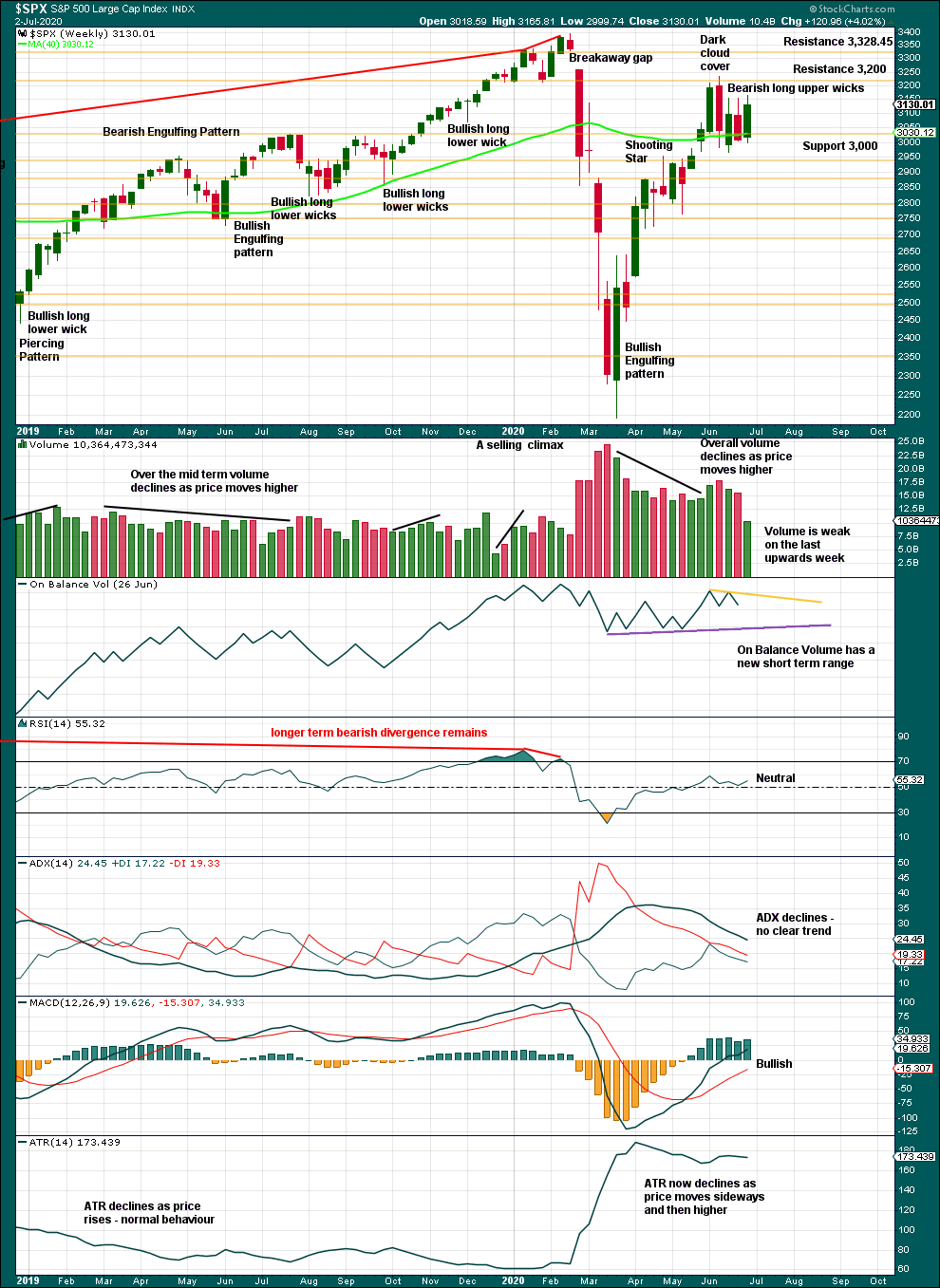
Click chart to enlarge. Chart courtesy of StockCharts.com.
Now three long upper wicks in a row is increasingly bearish. On Balance Volume turns down from resistance. Volume is very light, but this was a short week. Overall, for the short term at least, this chart looks bearish.
DAILY CHART

Click chart to enlarge. Chart courtesy of StockCharts.com.
The breakaway gap of 24th February has its upper edge at 3,328.45. A bearish analysis remains reasonable while this gap remains open. If this gap is closed, then a more bullish analysis that would expect new all time highs would increase in probability.
The island reversal is comprised of an exhaustion gap created on June 5th and now a possible breakaway gap created on June 11th. This has provided strong resistance so far. While the Island Reversal remains intact, it should be read as a bearish reversal pattern.
90% and 80% days are used to indicate a shift in sentiment from bearish to bullish, and vice versa. A sentiment shift occurs when one 90% or two back to back 80% days in one direction are then followed within three to four sessions by one 90% or two back to back 80% days in the opposite direction. This has occurred only twice on this chart.
The first instance is a 90% down day on the 18th of March followed by a 90% up day four sessions later on the 24th of March. It was this technical evidence that was primarily used to identify a sustainable low on the 23rd of March.
The second instance was a 90% up day on the 5th of June then an 80% up day on the 8th of June followed three sessions later by a very strong 90% down day on the 11th of June. This indicates a good probability that the high on the 8th of June may be sustainable.
On Balance Volume gives a bullish signal that supports the third alternate Elliott wave count, but at the weekly chart level On Balance Volume is more bearish.
BREADTH – AD LINE
WEEKLY CHART
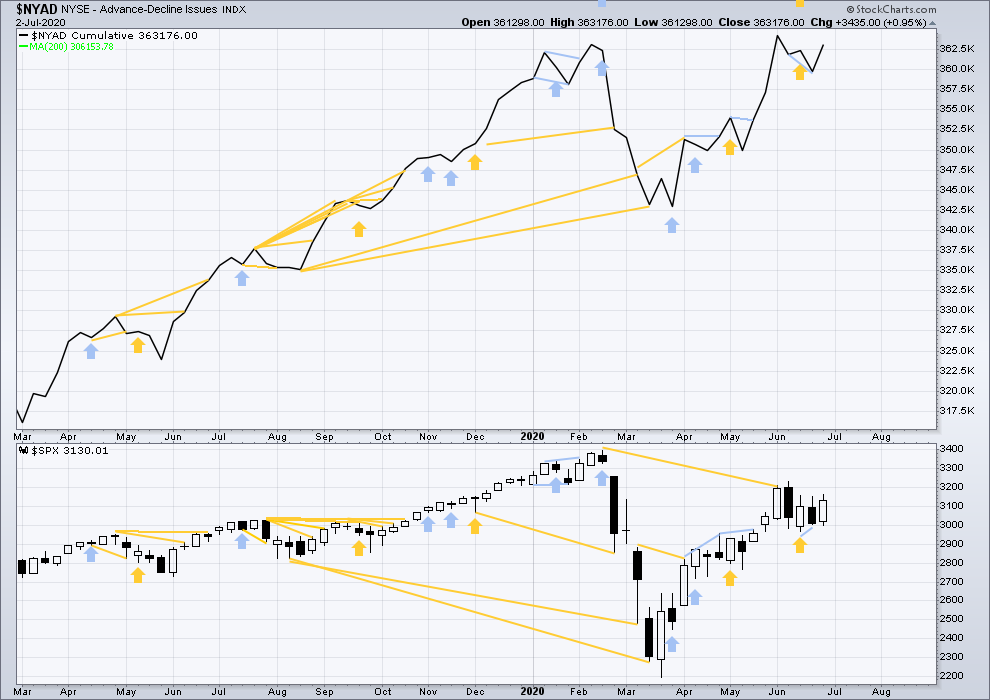
Click chart to enlarge. Chart courtesy of StockCharts.com. So that colour blind members are included, bearish signals will be noted with blue and bullish signals with yellow.
Breadth should be read as a leading indicator.
Bullish divergence noted five weeks ago remains.
This week price and the AD line have both moved higher. There is no new divergence.
Large caps all time high: 3,393.52 on 19th February 2020.
Mid caps all time high: 2,109.43 on 20th February 2020.
Small caps all time high: 1,100.58 on 27th August 2018.
This week only large caps have made a new short-term swing high above the prior swing high of the 16th of June. Small and mid caps have not. This rise this week was led by large caps, which is a feature of an aged bull market; this supports a bearish Elliott wave count.
DAILY CHART
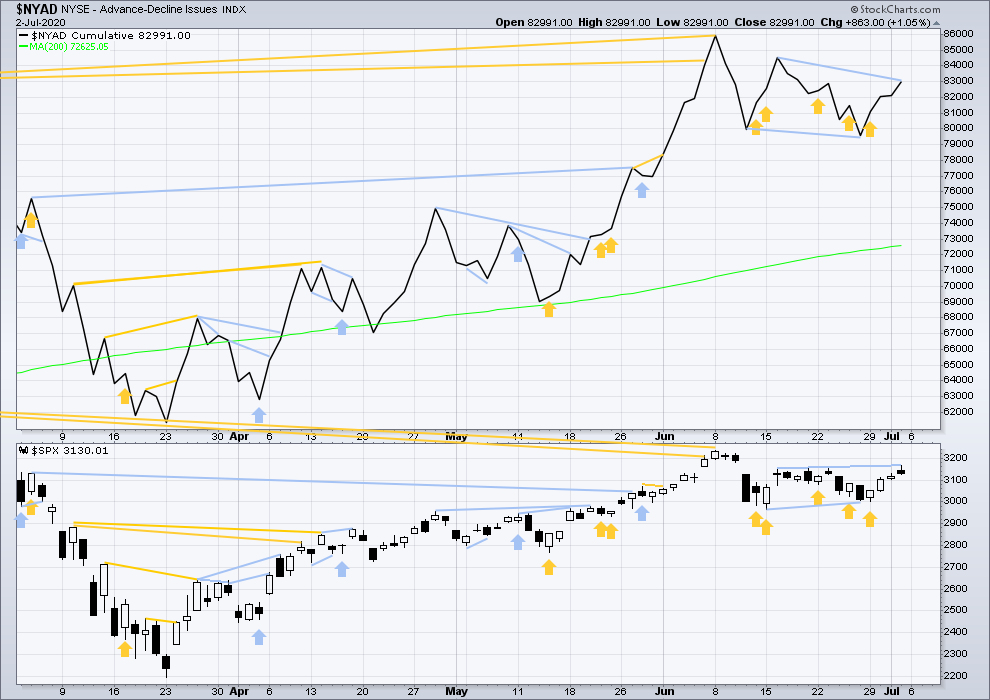
Click chart to enlarge. Chart courtesy of StockCharts.com. So that colour blind members are included, bearish signals will be noted with blue and bullish signals with yellow.
Although the NYSE AD line has made new all time highs on the 8th of June 2020, Lowry’s OCO AD line did not. Bullish divergence may still support a bullish wave count.
The AD line has made a new swing low, but price has not. This divergence is bearish.
Today price has made a slight new short-term swing high above the prior high of the 16th of June, but the AD line has not. Upwards movement does not have support from a corresponding rise in market breadth. This divergence is bearish.
VOLATILITY – INVERTED VIX CHART
WEEKLY CHART
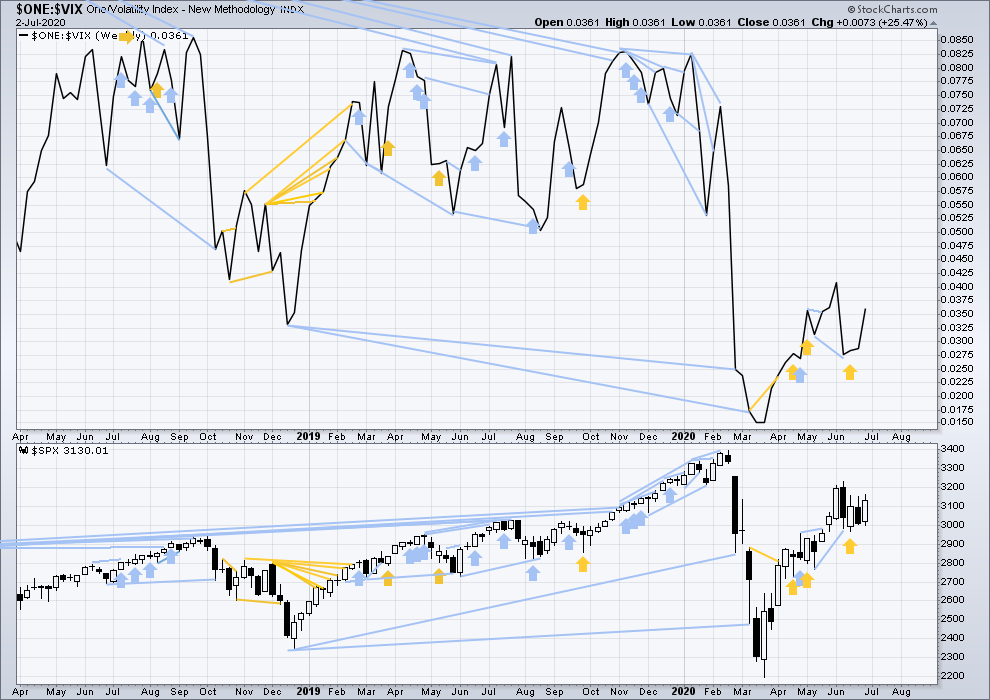
Click chart to enlarge. Chart courtesy of StockCharts.com. So that colour blind members are included, bearish signals will be noted with blue and bullish signals with yellow.
Inverted VIX remains well below all time highs. There remains over two years of strong bearish divergence between price and inverted VIX.
This week both price and inverted VIX have moved higher. There is no new short-term divergence.
DAILY CHART
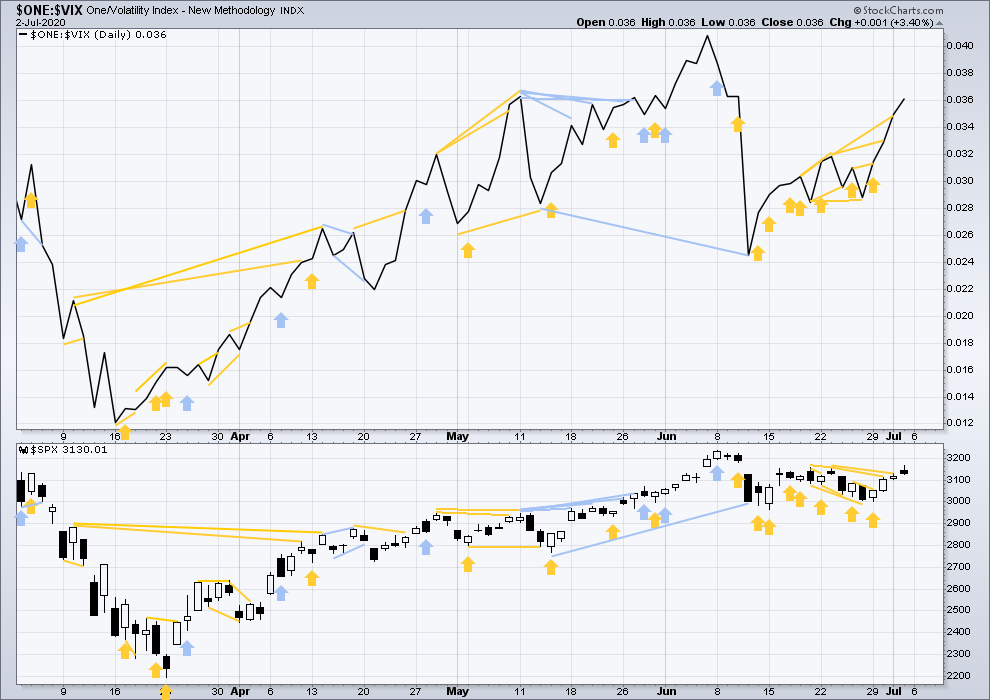
Click chart to enlarge. Chart courtesy of StockCharts.com. So that colour blind members are included, bearish signals will be noted with blue and bullish signals with yellow.
VIX has made a new swing low below the prior swing low of March 13th / 14th, but price has not. This divergence is bearish for the short to mid term and supports either the main or first alternate Elliott wave counts.
Today both inverted VIX and price have made new short-term swing highs. There is no new divergence. Short-term bullish divergence may now be resolved.
DOW THEORY
Dow Theory has confirmed a bear market with the following lows made on a closing basis:
DJIA: 21,712.53 – a close below this point has been made on the March 12, 2020.
DJT: 8,636.79 – a close below this point has been made on March 9, 2020.
Adding in the S&P and Nasdaq for an extended Dow Theory, a bear market has now been confirmed:
S&P500: 2,346.58 – a close below this point has now been made on March 20, 2020.
Nasdaq: 7,292.22 – a close below this point was made on the March 12, 2020.
At this time, to shift Dow Theory from viewing a bear market to confirmation of a new bull market would require new highs made on a closing basis:
DJIA – 29,568.57
DJT – 11,623.58
Adding in the S&P and Nasdaq for an extended Dow Theory:
S&P500 – 3,393.52
Nasdaq – 9,838.37 – closed above on June 8, 2020.
GOLD
A very small range day leaves all three Elliott wave counts the same.
Summary: While price remains above 1,759.10, assume the upwards trend remains intact and use the main Elliott wave count. The next target is at 1,980.
A new low below 1,759.10 would shift probability towards the alternate bearish Elliott wave count. A new low below 1,672.80 would increase probability in that wave count substantially. At that stage, the target would be at 1,408.
Price remains within the consolidation zone. The short-term volume profile and On Balance Volume remain bearish.
Grand SuperCycle analysis is here.
Monthly charts were last updated here.
MAIN BEARISH ELLIOTT WAVE COUNT
WEEKLY CHART
The bigger picture for this main bearish Elliott wave count sees Gold as still within a bear market, in a three steps back pattern that is labelled Grand Super Cycle wave IV on monthly charts.
Super Cycle wave (b) within Grand Super Cycle wave IV may be an incomplete double zigzag. When Super Cycle wave (b) may be complete, then this wave count expects Super Cycle wave (c) to begin and to move price below the end of Super Cycle wave (a) at 1,046.27.
The first zigzag in the double is labelled cycle wave w. The double is joined by a three in the opposite direction, a combination labelled cycle wave x. The second zigzag in the double is labelled cycle wave y.
The purpose of the second zigzag in a double is to deepen the correction. Cycle wave y has achieved this purpose.
We should always assume the trend remains the same until proven otherwise. At this stage, Gold is in a bull market for the mid term.
DAILY CHART
Primary wave C may be an incomplete five wave impulse.
Within the impulse: intermediate waves (1) through to (3) may be complete and intermediate wave (4) may be a double zigzag. No second wave correction within intermediate wave (5) may move beyond its start below 1,672.80.
Minor waves 1 and 2 within intermediate wave (5) may now be complete. Minor wave 3 is incomplete. When minor wave 4 arrives, then it may not move into minor wave 1 price territory below 1,743.81.
Draw a best fit channel about the start of intermediate wave (5) as shown. The lower edge of the channel may provide support for corrections along the way up.
ALTERNATE BEARISH ELLIOTT WAVE COUNT
WEEKLY CHART
This wave count has support from classic technical analysis.
It is possible that primary wave B is an incomplete expanded flat correction.
The only problem with this wave count is the size in terms of both duration and price travelled for primary wave B. It looks much larger than cycle wave w, but cycle wave y is already much longer than cycle wave w, so this may be acceptable.
If primary wave A is correctly labelled as a five wave structure, then primary wave B may not move beyond its start below 1,161.79.
DAILY CHART
Primary wave B may be continuing as an expanded flat correction. The most common range for intermediate wave (B) within an expanded flat is from 1 to 1.38 times the length of intermediate wave (A), giving a range from 1,687.92 to 1,777.09. If intermediate wave (B) has ended at the last high, then it would be a little longer than this range; intermediate wave (B) would be 1.43 times the length of intermediate wave (A). This very slightly reduces the probability of this wave count.
Intermediate wave (B) may now be a complete structure. A trend change would now be expected. Intermediate wave (C) downwards would be extremely likely to make at least a slight new low below the end of intermediate wave (A) at 1,453.26 to avoid a truncation and a very rare running flat.
A target is now calculated for intermediate wave (C) to end.
This alternate wave count sees an expanded flat unfolding for primary wave B, in mostly the same way as the alternate bullish wave count below sees an expanded flat unfolding for cycle wave IV.
ALTERNATE BULLISH ELLIOTT WAVE COUNT
WEEKLY CHART
This wave count sees the the bear market complete at the last major low for Gold on 3 December 2015.
If Gold is in a new bull market, then it should begin with a five wave structure upwards on the weekly chart.
Cycle wave I fits as a five wave impulse with reasonably proportionate corrections for primary waves 2 and 4.
Cycle wave II fits as a double flat. However, within the first flat correction labelled primary wave W, this wave count needs to ignore what looks like an obvious triangle from July to September 2016 (this can be seen labelled as a triangle on the bear wave count above). This movement must be labelled as a series of overlapping first and second waves. Ignoring this triangle reduces the probability of this wave count in Elliott wave terms.
Within the first flat correction labelled primary wave W of the double flat of cycle wave II, intermediate wave (B) is 1.69 the length of intermediate wave (A). This is longer than the common range of up to 1.38, but within an allowable guideline of up to 2. The length of intermediate wave (B) reduces the probability of this wave count.
Cycle wave III may be complete. Cycle wave IV may not move into cycle wave I price territory below 1,303.51.
DAILY CHART
Cycle wave IV may be an incomplete expanded flat correction. Primary wave A within the flat correction may have subdivided as a zigzag. Primary wave B may be continuing higher as a double zigzag.
The common range of primary wave B would extend up to 1.38 times the length of primary wave A at 1,795.98. A maximum allowable guideline for primary wave B would be up to 2 times the length of primary wave A at 1,949.96. There is no Elliott wave rule stating a limit for B waves within expanded flat corrections, so there is no rule which may be used to determine an upper invalidation point for this wave count.
If primary wave B is complete at the last high, then it would be 1.35 times the length of primary wave A, which is within the most common range.
Draw a best fit channel about intermediate wave (Y). Assume upwards movement may continue while price remains within the channel. If the channel is breached, then assume intermediate wave (Y) may be over.
TECHNICAL ANALYSIS
WEEKLY CHART
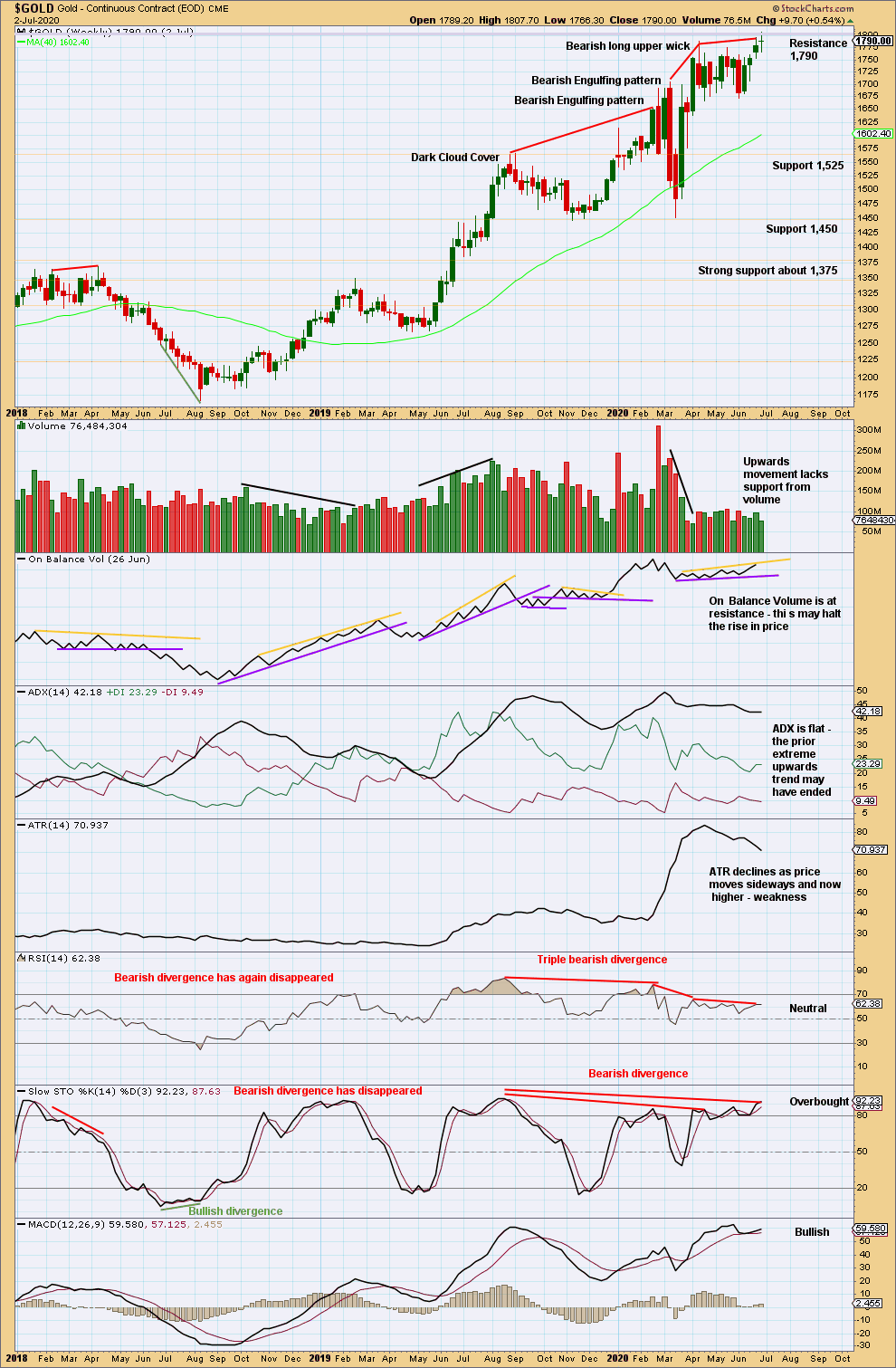
Click chart to enlarge. Chart courtesy of StockCharts.com.
Price remains within a consolidation with support about 1,665 to 1,680.
There is now strong triple bearish divergence between price and RSI. This supports either the alternate bearish Elliott wave count or the bullish Elliott wave count.
DAILY CHART
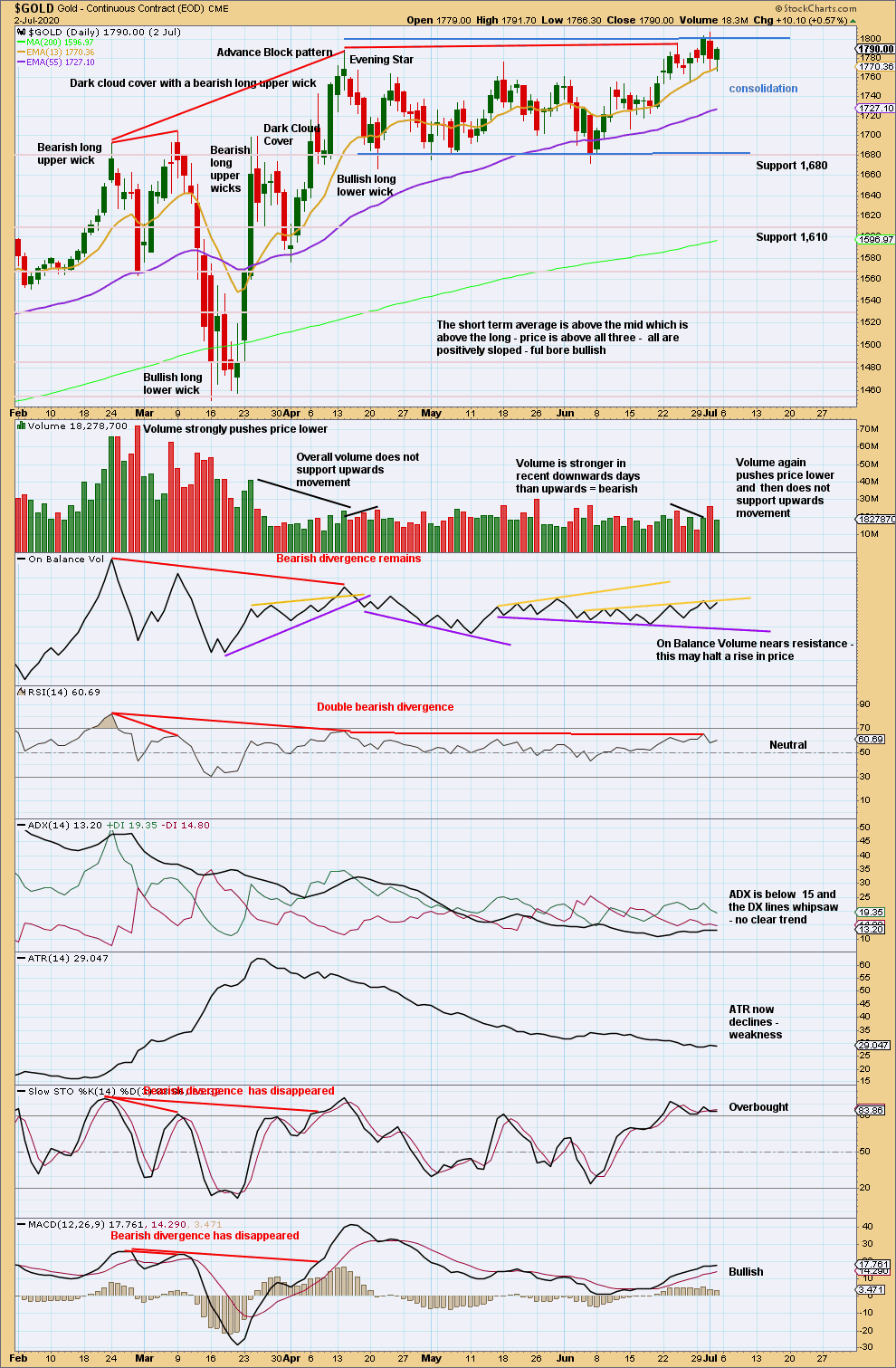
Click chart to enlarge. Chart courtesy of StockCharts.com.
StockCharts data is New York session only, so there is no candlestick for Friday the 3rd of July as New York was closed.
Resistance for the current consolidation is pushed slightly higher. The consolidation zone now spans from resistance about 1,800 to support about 1,680.
Volume and On Balance Volume still suggest a downwards breakout may be more likely than upwards.
GDX WEEKLY CHART
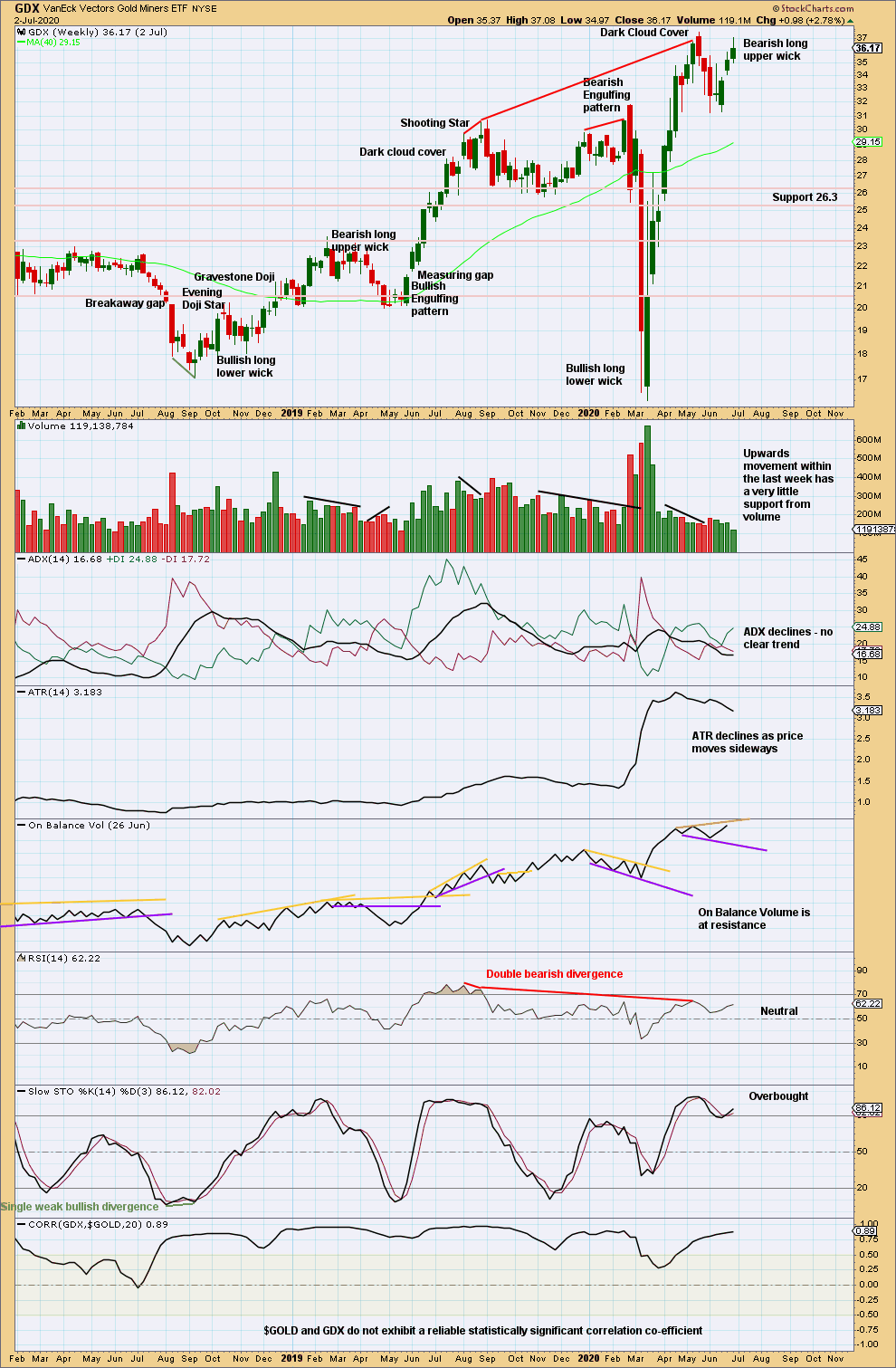
Click chart to enlarge. Chart courtesy of StockCharts.com.
Overall, range and volume are declining as price moves higher. Price is range bound.
GDX DAILY CHART
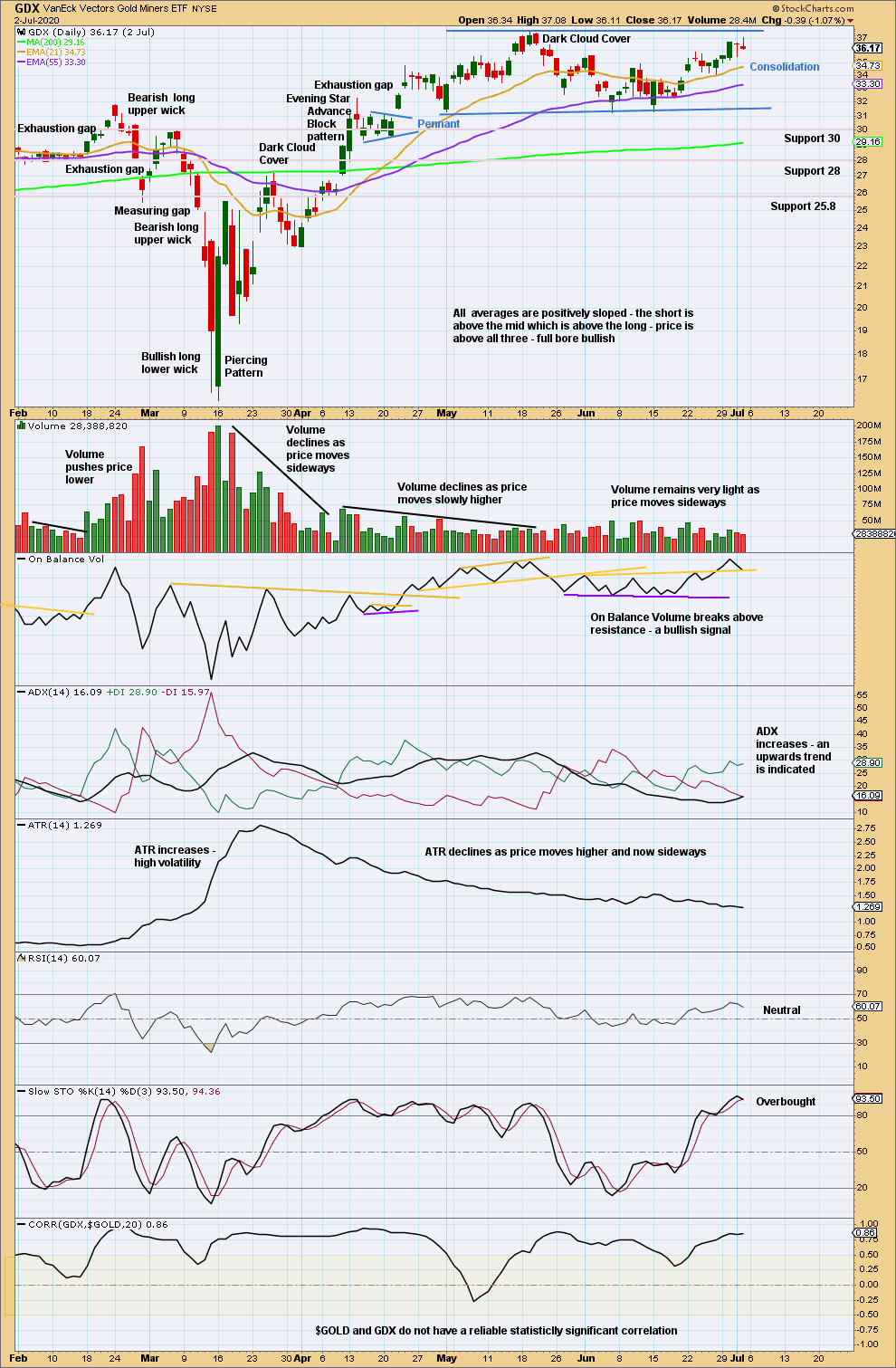
Click chart to enlarge. Chart courtesy of StockCharts.com.
Price is range bound with resistance about 35.55 to 37.50 and support about 31.20 to 31.30. A breakout of this range is required before having confidence in a trend. An upwards breakout should have support from volume for confidence. A downwards breakout does not require volume for support.
The bullish signal from On Balance Volume may now be negated. On Balance Volume may be returning to below support, but at this stage that is not clear. If there is another downwards session tomorrow, then the resistance line for On Balance Volume may need to be redrawn.
US OIL
An inside week leaves all three Elliott wave counts the same.
Summary: Oil may have found a major sustainable low.
For the mid term, a multi-week pullback may end about 31.75 or 22.23. It is possible the pullback may be deeper than this though; the first major correction within a new trend for Oil tends to be very deep.
When this pullback may be complete, then an upwards trend should resume with increased strength.
ELLIOTT WAVE COUNT
MONTHLY CHART
The basic Elliott wave structure is five steps forward and three steps back. This Elliott wave count expects that US Oil has completed a three steps back pattern, which began in July 2008. The Elliott wave count expects that the bear market for US Oil may now be over.
A channel is drawn about Super Cycle wave (II): draw the first trend line from the start of cycle wave w to the end of cycle wave x, then place a parallel copy on the end of cycle wave w. Price has bounced up off the channel. This trend line is breached, which is a typical look for the end of a movement for a commodity.
The upper edge of the channel may provide resistance.
Following five waves up and three steps back should be another five steps up; this is labelled Super Cycle wave (III), which may only have just begun. Super Cycle wave (III) may last a generation and must make a new high above the end of Super Cycle wave (I) at 146.73.
Super Cycle wave (III) may only subdivide as a five wave impulse. New trends for Oil usually start out very slowly with short first waves and deep time consuming second wave corrections. Basing action over a few years may now have begun.
WEEKLY CHART
Super Cycle wave (III) must subdivide as an impulse. Cycle wave I within the impulse may now be unfolding higher. Cycle wave II may not move beyond the start of cycle wave I below 10.24.
DAILY CHART
Labels are added for cycle wave I. Primary wave 1 within an impulse for cycle wave I may now be complete.
Primary wave 2 may be unfolding as an expanded flat correction. Intermediate wave (A) within the flat may be a complete zigzag. Intermediate wave (B) may also be a complete zigzag, at 1.2 times the length of intermediate wave (a). This is within the common range for intermediate wave (B) within a flat from 1 to 1.38 times the length of intermediate wave (A), giving a range from 40.44 to 42.75.
A target is calculated for primary wave 2 that expects a common Fibonacci ratio between intermediate waves (A) and (C).
Primary wave 2 may not move beyond the start of primary wave 1 below 10.24.
ALTERNATE DAILY CHART
It is possible that primary wave 1 may have ended at the last high.
Primary wave 2 may have begun at the last high. The most common structure for a second wave is a zigzag. Primary wave 2 may end about the 0.618 Fibonacci ratio of primary wave 1, or it may be deeper than that target.
Primary wave 2 may not move beyond the start of primary wave 1 below 10.24.
SECOND ALTERNATE DAILY CHART
It is also possible that primary wave 1 may be incomplete.
Intermediate wave (3) within primary wave 1 may be complete at the last high. Intermediate wave (3) at 17.25 in length is shorter than intermediate wave (1) at 17.73 in length. For this wave count, if intermediate wave (5) has begun at the low for June 25th, then it is limited to no longer than equality in length with intermediate wave (3) at 54.33.
Intermediate wave (4) may not move into intermediate wave (1) price territory below 27.97.
Primary wave 2 may not move beyond the start of primary wave 1 below 10.24.
TECHNICAL ANALYSIS
WEEKLY CHART
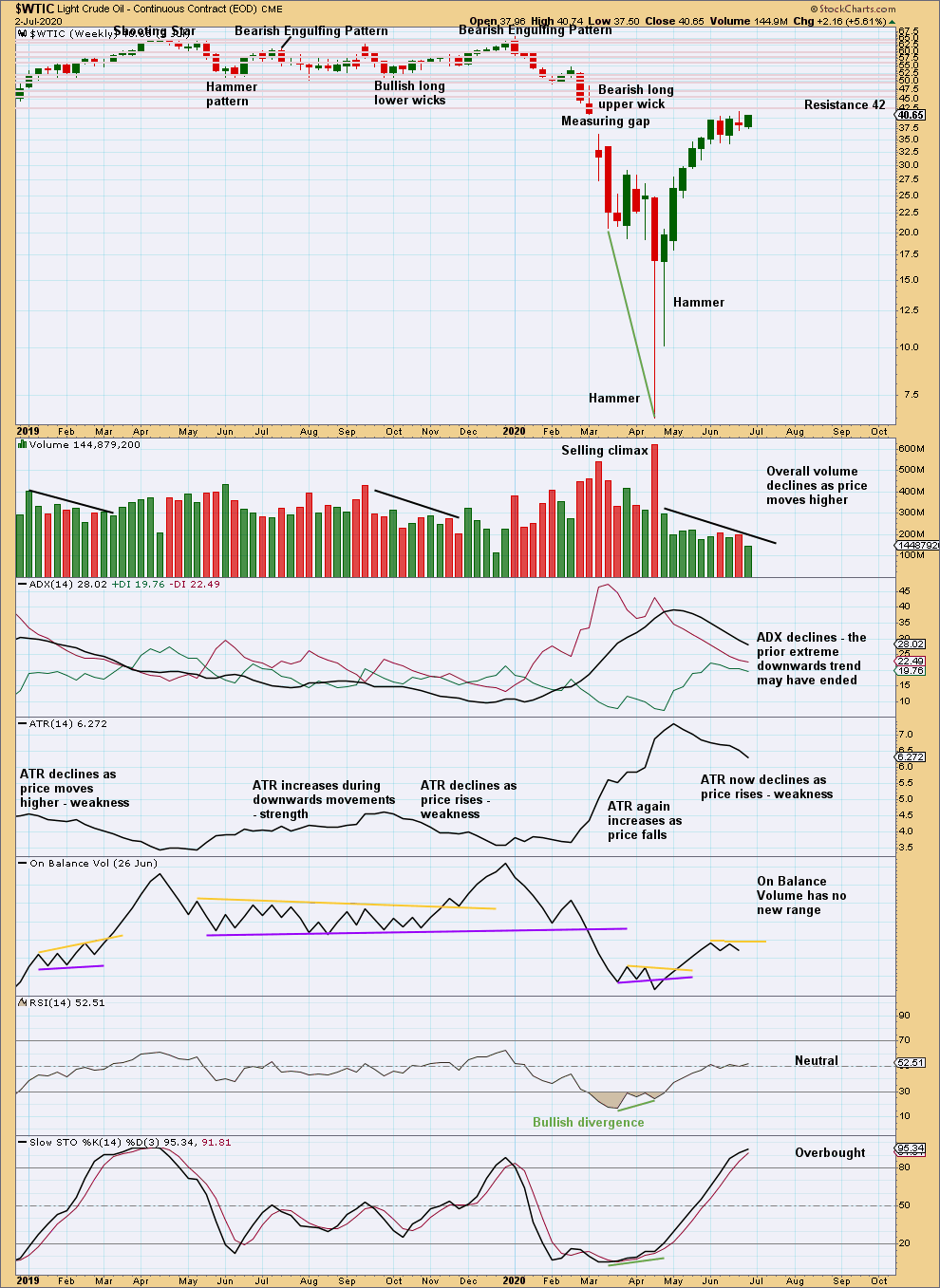
Click chart to enlarge. Chart courtesy of StockCharts.com.
The short-term volume profile remains slightly bearish and price remains just below a strong cluster of resistance. With Stochastics now overbought, the risk of a multi-week pullback remains high.
DAILY CHART
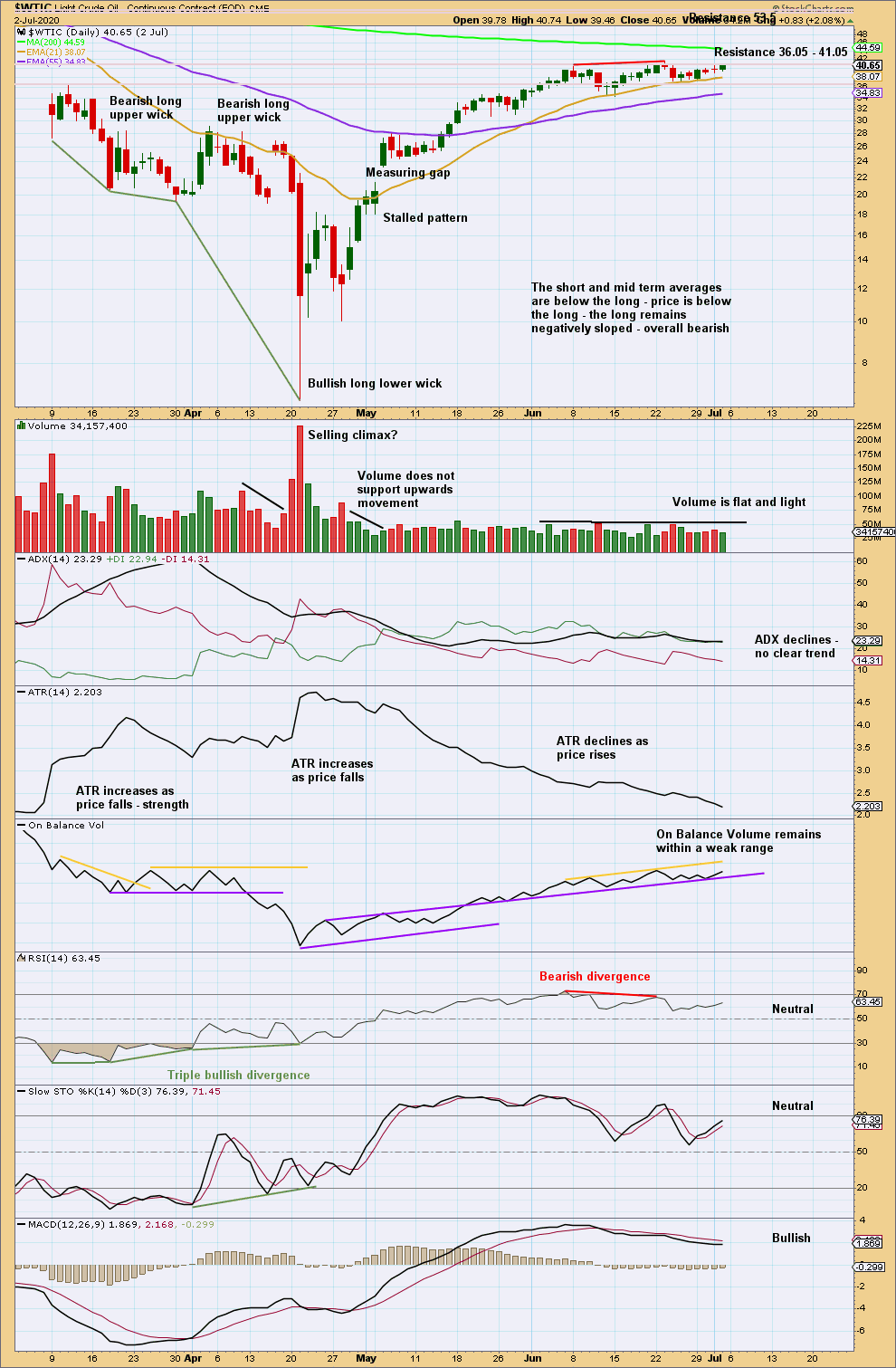
Click chart to enlarge. Chart courtesy of StockCharts.com.
Bearish divergence with price and RSI is clear. The probability of a multi-week pullback remains high.
—
Always practice good risk management as the most important aspect of trading. Always trade with stops and invest only 1-5% of equity on any one trade. Failure to manage risk is the most common mistake new traders make.

